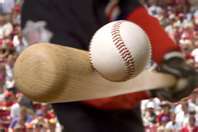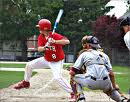Baseball Hitting Instruction - Switch Hitting
Let's talk Baseball Hitting Instruction and that includes being able to proficiently Switch Hit which will increase a player’s value, especially as players become older and more skill intensive. I realize learning to hit from one side, your natural side, is hard enough. Why throw learning to hit right or left handed in the pot.
As a player approaches the age of playing High School Baseball and his strength, speed and abilities develop changing the way he plays the game, the game itself changes also.

"The Natural Batting Side Position Will Appear Smooth & Fluid" -
Baseball Hitting Instruction
Coaches begin making position moves during a game based on percentages and odds rather than just gut feelings. He’ll bring in a left handed pitcher to face a left handed batter, although his right handed reliever was throwing well, based solely on percentages.
When analyzing talent during tryouts a Coach and his assistants, will grade the performance of each player as he performs the tasks of hitting, fielding and throwing. This grade card is then tabulated into terms of what good will this player do for the team.
This is the point where being able to switch hit could be the determining factor if you make the team or not. I don’t know any Coach which, all other factors considered between two players being equal, who wouldn’t choose the player who could switch hit to be on the team.

Baseball Hitting Instruction
So how do we go about learning to switch hit?
As a starting point, Mickey Mantle is the only player I’m aware of who hit consistently the same whether hitting left or right handed. He’s in the Baseball Hall of Fame.
The very first thing to be aware of is You will NOT feel the same when hitting from both sides of the plate.
You will for the most part, feel more comfortable hitting from your natural side and somewhat awkward and clumsy hitting from the other side of the plate.

Feeling Awkward - Baseball Hitting Instruction
Although this should be obvious, I’ve know many players who I believe had the talent to become very good hitting from either side, who quickly discarded the idea because they felt awkward hitting from the opposite side.
Another, what should be obvious difference except in very rare cases, you’ll be a different type of hitter as you switch hit. In almost all cases you will have more power hitting from your natural side.
Not to say you can’t hit a home run from your opposite side, but it’s not as likely. Why?
Theoretically, the body’s entire hitting system, muscles, eyes, mind have been trained one way to react as you hit. Turn the body around backwards and this entire system must immediately adapt new memory.
In this scenario the mind reverts back to basics, make contact with the ball. It’s not concerned with power, only contact. That’s why, without hundreds of hours of practice and even then, you’ll be a different style of hitter from each side.

Switch Hit Bunting - Baseball Hitting Instruction
I’ve known of coaches who have forced a star hitter, mired in a hitting slump he just can’t seem to break out of, to hit from the other side during practice. By going back to the basics of intently watching the ball and swinging for contact instead of power, the hitter becomes better.
Sometimes you have to go backwards to go forward.
Here is the system I used for my players when learning to switch hit. They began by hitting off a batting tee extensively. This began to somewhat acclimated their body and mind to the new and awkward physical task of hitting from the opposite side.
This drill was used until the hitter could solidly hit ten balls in a row off the tee. After all, if you can’t hit a ball setting still you definitely won’t hit one moving.
Once they demonstrated they could perform this drill (which also increased their confidence immensely) they moved to taking swings in a batting cage.
They were instructed to concentrate solely on making contact, not power.
After establishing a reasonable skill level at making contact with a moving ball, they began switch hitting during batting practice. The first few times they batted from the opposite side only, after which they’d hit from their natural side, then switch and hit five pitches.
The next situation is on the Coach. More than likely the player will not volunteer to switch hit during a game. You, as the coach must pick the time to force the player to hit from the opposite side.
Obviously, it won’t be in a situation where failure on the player’s part to safely hit would shatter his confidence, but a game that is hopelessly lost or won, or a padded lead late in the game is an ideal opportunity.
In summation the learning of being able to switch hit, unless it comes naturally, should be a skill which is practiced as a part time drill, similar to a drill of catching fly balls over the shoulder.
It’s a skill which could make the difference in making the team or not.
Baseball Hitting Instruction Back to Teaching Hitting

New! Comments
Have your say about what you just read! Leave me a comment in the box below.